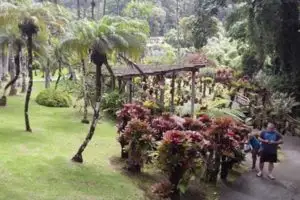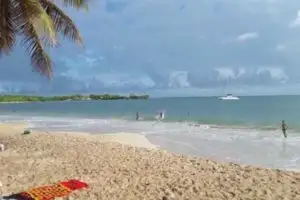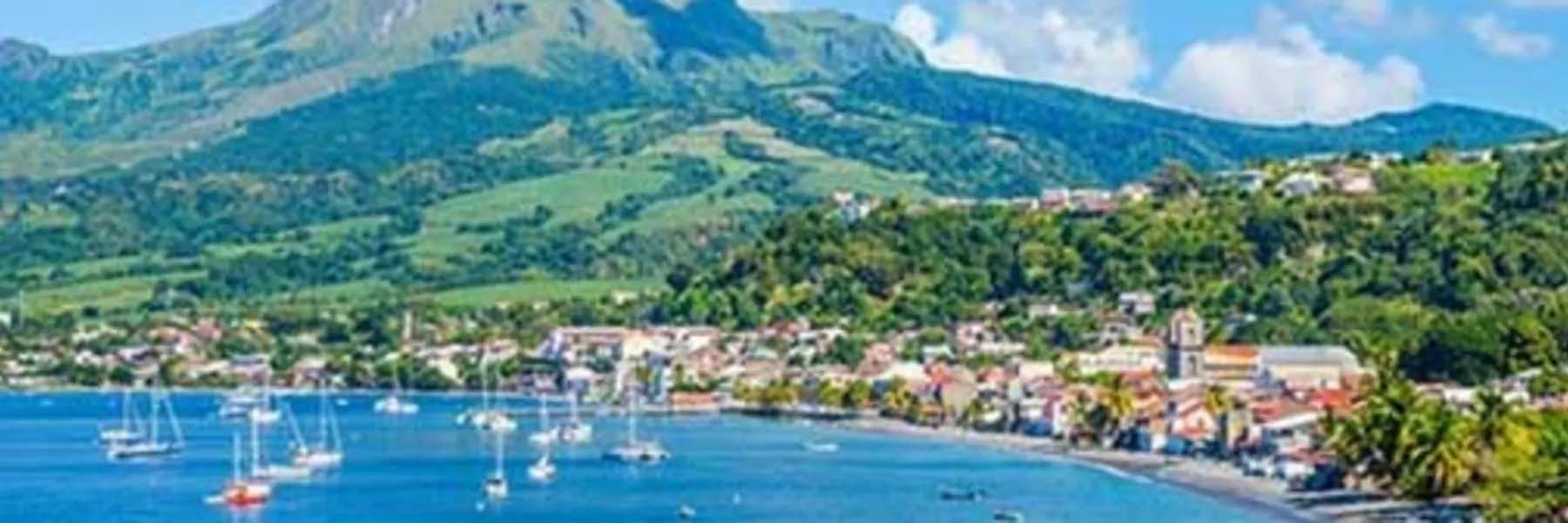Want France with a Caribbean flair? Try the island of Martinique. Largest of the French possessions of the Windward and Leeward Islands, with a population of over 370,000 people.
My family and I recently flew to Martinique from Miami on a direct three-and-a half hour flight. On arrival in Fort de France, Martinique's capital, we navigated our way through the modern yet moderately sized airport, although it does possess the usual run of services and stores (including a duty free shop). American, Air France, Copa, and Caribbean all fly out from here.
On exiting, the airport we were happy to see that vehicle rentals were placed just across from the main entrance, and we were promptly acquainted with the seven-passenger van we had reserved. Once on the road we quickly saw roads are well paved, marked, and with easy to follow directions.

It also became obvious quite quickly, why Martinique’s original inhabitants called it the “isle of flowers” with stunning vistas of greenery and bright flowers at virtually every turn.
We had prepared for our trip by watching videos on Martinique and buying a guide. A guidebook proved a handy resource for useful information including; the pharmacies, shops, restaurants, type of cuisine and prices, medical, and other services available as well as the dates and times when they are open. We also had the advantage of an on-site guide in my cousin (once removed), Julien, who lives there, along with the added surprise of his parents arriving from the Bordeaux region. Julien is a lycée instructor (teacher in a French school) and became so captivated by the island that he permanently ‘expatriated’ from the mainland 10 years ago.
Most of Martinique's population lives in towns and villages located on the beaches, coves, and bays that surround the island. The northern part of Martinique is dominated by the volcano Pelee—named after the mythical goddess of fire, which erupted in 1902, devastating that part of the island. It has since been rebuilt but most of the population lives well south of it, but the Pelee area is frequented by hikers and campers fascinated by its rain-forest environment.

Martinique is blessed with a consistent climate ranging from the low 70s F to the high 80s F. A sea breeze from the east makes outdoor pursuits a comfortable experience. While not sufficiently far enough south as to be immune from the effects of all hurricanes, most pass well north of the island.
Visitors will find a wide range of accommodations including hotels and vacation rentals such as VRBO. The French love of food and wine can be enjoyed in a wide variety of restaurants and eateries found not only in populated areas but also along the roadways. These can range from family cafes under thatched palm-frond roofs serving Creole inspired dishes at one end of the spectrum, to the most elegant of haute cuisine establishments at the other. We used the latest cruising guide and our cousin’s knowledge of the island as the basis of our choices and we were always satisfied. We dined at a great restaurant called La Luciole in Fort-de-Force and our bill for three people including a main course drinks and desserts came to only $53. For those more inclined to cook at home, supermarkets and one stop shopping can be found in any of the moderate sized communities. We shopped at Le Carrefour and Price Leader for drinks and baked goods and found them to be sufficient for our needs.
Rum, one of Martinique’s main exports, is produced at several sugar plantations (‘habitations” as they are called) where a wide variety of the liquor’s qualities can be tasted, bought, and shipped to wherever buyers desire. Three of the larger of these, Habitation Clement, Saint-Etienne, and Rhum J.M. are surrounded by parks and gardens, some dotted with works of contemporary art for the enjoyment of visitors. Plan to spend the better part of the day here enjoying them.

Water sports; from boating, kayaking, paddle boarding, parasailing, snorkeling, scuba diving, and deep-sea fishing etc., are available throughout the island. The more popular venues have ample parking and stalls for drinks and food almost at the water’s edge. Home-made ice cream sold from refrigerated carts is not to be missed.
Martinique contains all the well-supported infrastructures that are found on the French mainland, especially healthcare and education. Agriculture and local industry account for about 20% of the islands GDP with tourism adding its economic contribution. For the rest, Martinique depends on support from the mainland to make up the deficits. That does not mean that the island is impoverished—quite the opposite. Night clubs, pubs, and even a casino are abundant in the capital, and to a lesser extent in cities such as Marin (aptly named ‘sailor’ in French) whose large protected harbor makes it an ideal mooring place for cruising yachts that use it as a stopover for resupplying, or as a respite from time at sea. Should you wish to mix with a group of adventurous international and cosmopolitan people, Marin is the place to be.

Martinique offers unmatched real estate security with prices that are well below those found in France or the U.S. Anyone considering an extended stay has an ample supply of long-term rentals advertised online. Those contemplating a more permanent move should consider property guides to round out their understanding of the procedures for buying or renting according to French laws. Terraced studio apartments start just under $50,000 for local style villa homes, and with pools from the mid-$100,000. Those looking to buy property for a business can expect to spend more. Zoning laws are quite firm and land set aside for farming or as preserves are not easily changed.
Without question the other alluring aspects of the island are not only the low incidence of crime (most are of the petty sort and non-violent) but even more so the joyful hospitable attitudes of the people that live here. Come retirement time, we will be strongly tempted to follow in my cousins footsteps. But, if that doesn’t happen, we will certainly revisit this “Isle of Flowers” with great regularity in the years to come.
Related Articles
5 Best Caribbean Islands to Live On and 2 to Avoid
Everthing You Need to Know About Caribbean Islands and More
The Best Places for Scuba Diving and Kiteboarding in the Caribbean
